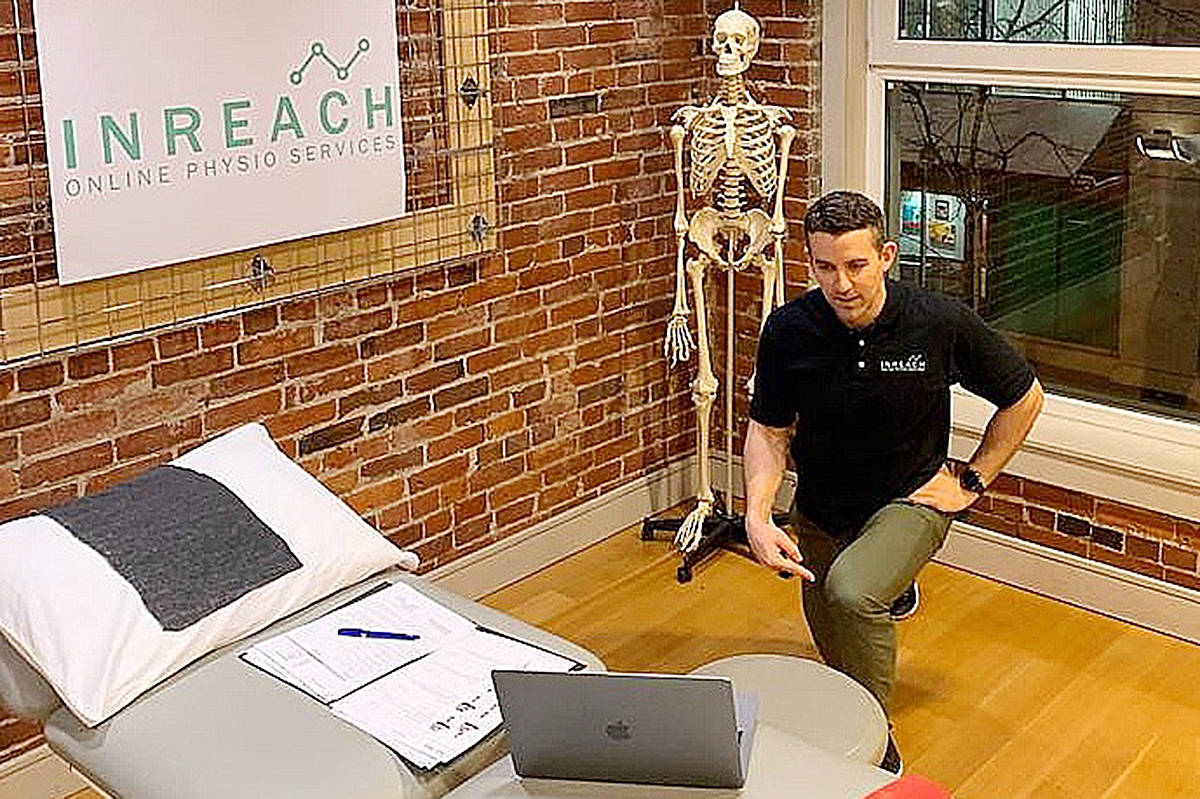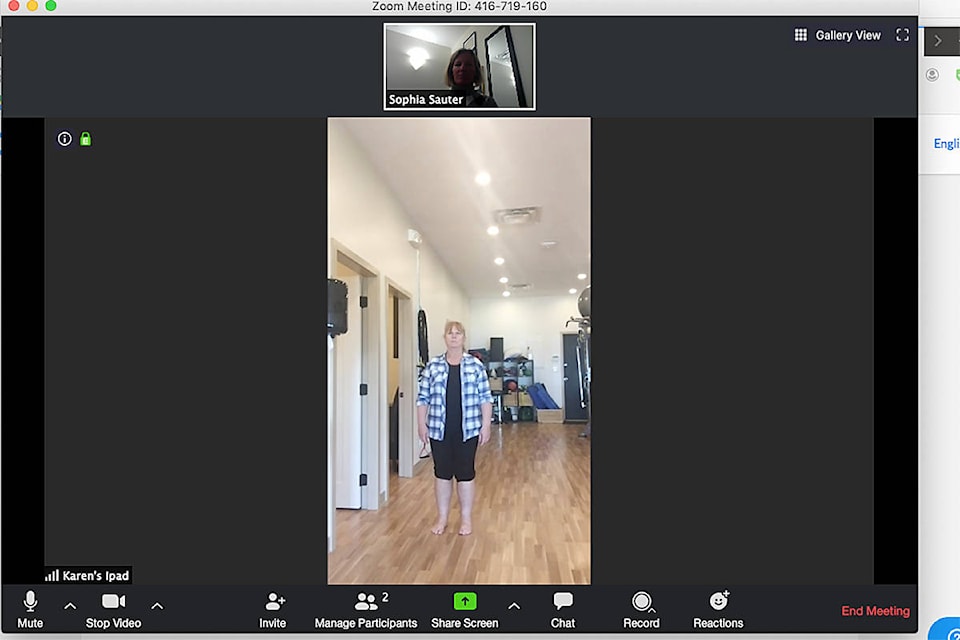Just because services, jobs, and socializing have been put on hold, it doesn’t mean your injuries have been as well.
That’s why physiotherapy clinics are offering “telerehab,” the provision of services remotely during the COVID-19 pandemic.
Sophia Sauter of Active Living Physiotherapy in Campbell River says during this period of social isolation, face-to-face physiotherapy can’t be provided but it is strongly recommended that people continue to stay active and exercise for all the physical and mental health benefits. In fact, it might even be more important than ever to help people cope with the current situation.
“So, if people are still out there exercising (or should be!) and getting hurt, they will continue to need physiotherapy,” Sauter said.
Sauter is trying to stay open virtually and so is switching to either phone or video conference calls.
“The word for it is ‘telerehab,’ ” Sauter said.
Telerehab is actually not something completely new, developed with the rise of the COVID-19 pandemic. It’s being used in other fields of medicine under the term telehealth or virtual care, Sauter said. The physiotherapy application of it is called telerehabilitation.
It is something that Sauter has wanted to launch for a year at least, since she attended a seminar on it in Vancouver. But it wasn’t until spring break of this year that she spent some time putting a plan together.
Erica Farrell is a physiotherapist based in the Comox Valley and owns Child’s Play Physiotherapy, which offers occupational therapy and physiotherapy for children. She has caught on to the telerehab concept as a way to reach her clients throughout central Vancouver Island.
“Now that we can’t see our clients one-on-one,” Farrell said.
Farrell usually makes use of community facilities – swimming pools, playgrounds and the like – and in-home service to tend to her clients. It’s a very hands-on approach, usually.
“Families have liked us being in their homes and using their stuff and showing them what they can do in their own surroundings,” Farrell said. “And families have liked not having to pack up their kids and bring them to a centre.”
Now, obviously, the therapist can’t go into their homes or go into swimming pools or playgrounds with facilities closed and social distancing recommended.
“So we’ve followed what other therapists have been doing for a while and have been looking into providing telehealth,” Farrell said.
Farrell has approached some clients already and has been quite pleased with the results. The kids, meanwhile, find it interesting to have their therapist on the T.V. screen.
“I think, actually, some of the kids think Erica onscreen is way cooler than Erica in person,” Farrell said.
The computer and video platforms allow you to put up resources on the screen, like a video to follow along or an exercise to try. And parents are recruited into helping on the other side of the screen.
“The parents seem to be really buying in,” Farrell said.
The parents get to to be hands-on and know what the therapist actually does because they are being coached through it.
“So that’s a benefit I hadn’t actually expected to see,” Farrell said. “But so far, parents seem to be enjoying being hands on with their children.”
You can maintain continued contact with your physiotherapist during your rehab journey. The physiotherapist has access to your physiotherapy medical charts and imaging reports. They are able to diagnose your injury because they can do over video many of the examination tests they would normally do, sometimes with the assistance of the patient themselves.
Research shows that the diagnostic accuracy of telerehab assessments is not inferior to face-to-face assessments, Sauter said.
Natasha Wilch has been doing telerehab since 2017 and teaches seminars on it on the web. The courses focus on one of two aspects: teaching clinic owners everything they need to set up telerehab service and teaching therapists the actual skills.
Wilch has been doing it as a practice herself for three years using it to provide services to people in more remote settings but, aside for remotve service, prior to the COVID-19 pandemic, telehealth was a bit of a hard sell.
“Why would I do telehealth if I can have someone come see me?” Wilch said.
But that has changed with COVID-19.
Aaron Dobie of InReach Online Physiotherapy treats throughout B.C. and says prior to COVID-19, telephysio, as he calls it, was mainly used to treat patients in northern and rural communities where in-person physiotherapy is limited. In addition, some patients preferred not to leave the comfort of their homes or were too busy to travel to in-person appointments and they availed themselves of telephysio services. That situation has now changed and telephysio service is seeing increased interest in all areas of B.C. due to clinic closures.
“Many of the conditions typically seen in a physiotherapy clinic are now possible to treat using modern technology,” Dobie said.
But can you trust it?
“Patients can expect the same safe, quality care that you would get during an in-person visit at Active Living Physiotherapy,” Sauter said.
Physiotherapists are required to meet the same Standards of Practice established by the College of Physiotherapists of B.C. Appointments are completely confidential, not recorded, and charted normally. A secure, encrypted video platform is used and visits are private. Your physiotherapist will be in their home office, and you can choose your choice of location. Active Living Physiotherapy has an example video of what an appointment is like.
The downside of telerehab is missing out on the hands-on portion of a physiotherapy treatment – massage, manual therapy, needling, etc.
But, with a little adaptation, Active Living can teach you how to perform at-home treatment techniques with a foam roller, trigger point ball, or even random household items like a towel, belt, milk jugs or soup cans used as weights. Plus you can have a family member assist.
Approximately 50-70 per cent of a physiotherapy treatment consists of appropriate exercise prescription, and patient education which is easily done over video calls.
All you need is a phone for the most basic appointment. For video calls, you’ll need an internet connection, an email address, a computer, laptop, tablet or mobile phone and a room with an area to sit, stand and lie down (which you can use a mat or bed for.)
Farrell said she is probably going to provide service via the Zoom platform which she feels will meet their needs and is a stable service. It will allow them to maintain their connection with families but still protect their privacy and make sure it’s safe.
“We are going to have to change our ways, be creative, come up with new ways of doing things, and stay positive. And most importantly, we need to continue to look after our health,” Sauter said. “This situation isn’t going to go away anytime soon. Sure, your first video appointment may not go perfectly without any glitches, but I think you’ll be surprised what we can do remotely and we’ll all get better with practice! I’m excited about what we are offering at the clinic – something for everyone, and I encourage you to give it a try. It’s easier than you think.”
Another aspect is the business perspective, particularly the aspect of supporting local businesses during this time.
RELATED:
editor@campbellrivermirror.com
Like us on and follow us on





